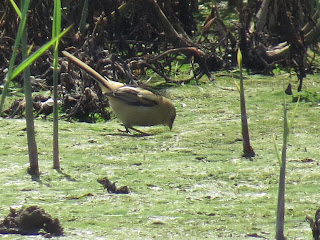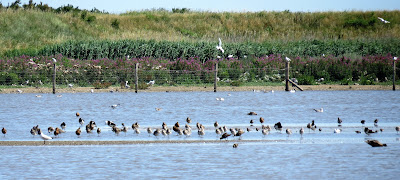 |
| A young Robin |
A rather warm day out at Titchwell today and the horseflies were at their worst! We ignored these biting nuisances as best as we could, despite forgetting the insect repellent back at the car, as we continued onwards towards the hides and the beach. It turned out to be one of those days where most of the wildlife were as far away as possible with the heat haze distorting most of my photographs today. So I apologize in advance on the quality of my shots that I took during this particular visit.
 |
| Wall Brown Butterfly |
 |
| Common Toad (which made Mum scream out in terror as it hopped by) |
 |
| Bearded Tit |
This month, the staff at Titchwell are trying to raise money to build a new hide at Snettisham to replace the two that were destroyed by the surge of 2013. Today, they were raising money from bearded tit spotting at the Island Hide. Bearded tits are a bit of a star species here and they are more than likely on many people's wish list. Thankfully, there were a few young birds hopping around the mud along the reed bed edges adjacent to the hide and the staff were pointing them out to visitors for a small donation fee. A worthy course if it means you get good views of a few great birds.
 |
| The Parrinder Hides |
Out on the pools, there was a large patch of black and white near the Parrinder hides, nearly all of them being avocets, while elsewhere there were large flocks of bar-tailed and black-tailed godwits with dunlins, ruffs, oystercatchers and redshanks feeding alongside them. I also saw a little gull, a couple of little ringed plovers, a few linnets and reed buntings and a family of marsh harriers. But as I mentioned earlier, most of these birds were a bit distant and a heat haze did make it difficult in getting many decent shots of them all. On the beach, the tide was in and a small group of sanderlings were patrolling the tideline for a quick morsel to eat. It wasn't the most memorable of days at Titchwell, but I did see a few decent things here and there.
 |
| Avocets |
 |
| Add caption |
 |
| Oystercatchers |
 |
| Oystercatchers and other waders |
 |
| Black-tailed Godwits |
 |
| Juvenile Black-headed Gull |

 |
| Common Tern |
 |
| Little Gull (left) with young Black-headed Gull |
 |
| Ruff |
 |
| Juvenile Little Ringed Plover |
 |
| Linnet |
 |
| Sanderlings |
 |
| Dog Whelk? |
 |
| A mermaid's purse (egg case of a ray or dog shark) |
 |
| Shore Crab carapace |
 |
| A winged Black Ant queen |
Back home, I noticed a swarm of chunky ants with wings by the gate leading to my flat. I then noticed that one of them was sitting on the outside of my living room window. So I caught it with one of my bug pots for a better a look. It seems that today is a flying ant day as this is a young queen black ant. During a few brief evenings every summer, hundreds of winged queens and males emerge from their colonies and they set of to mate and start new colonies of their own. Once mating is complete, the queens will shed their wings and retreat back underground, while the males simply die. These swarms can be quite a nuscence to some people, but to other wildlife, this is a bonanza of food not to miss out on.



























































No comments:
Post a Comment